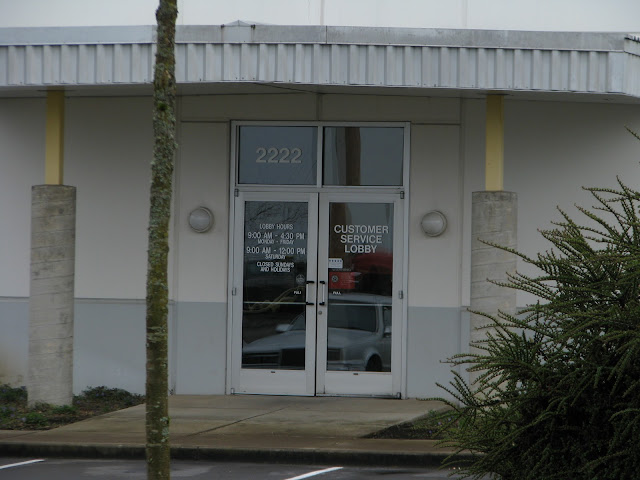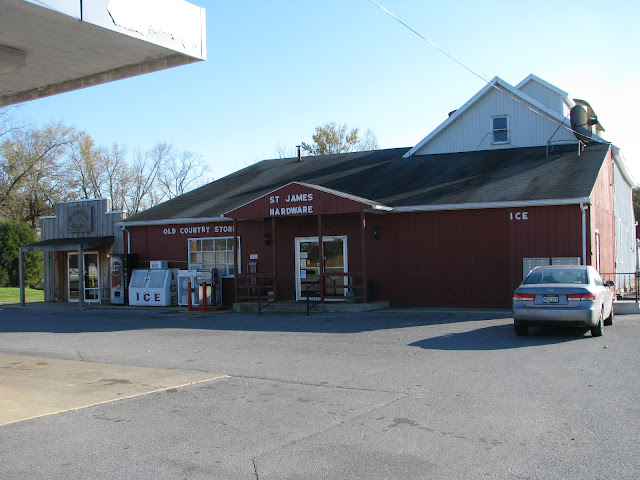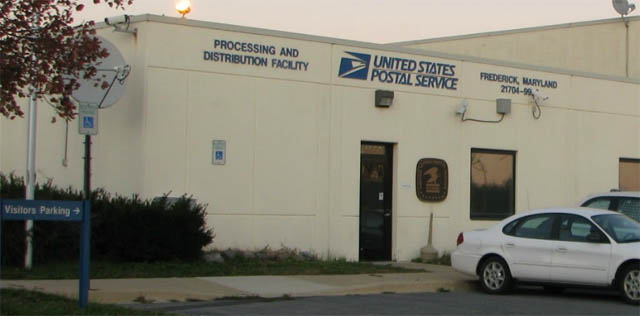(Folks can get full information about Carrier Annexes, at least if they know where one is, or if one's mail is delivered from one, by using 1-800-ASK-USPS, selecting option 5 from the main menu, stating "delivery offices", and entering the ZIP code in question. These locations' addresses are also noted on USPS's published Leased / Owned Facilities Report. So what I'm posting here, while not commonly known, is not really sensitive information. The photos I provide here are solely of the buildings' fronts and taken from public roads. For the record, the fantastic resource that is the Post Mark Collectors Club (PMCC)'s impeccable
Post Office Directory notes the existence of annexes.)
The postal facilities with which most of the American populace is familiar are USPS retail facilities -- Post Offices, classified branches and stations. Of course, USPS involves the delivery of mail as well as its intake. Excluding the world of CPUs, P&DC/Fs, Vehicle Maintenance Facilities, and other various postal knickknacks, of interest in this entry is the delivery operation, which is often conducted at a postal Carrier Annex. Many post offices will have both retail and carriers in the same facility, but sometimes these operations are separated. Retail-only urban locations are often called Finance Stations, and carrier-only bases are called Carrier Annexes (or, at times, Detached Carrier Units).
Since not many people get to see them, I thought it would be fun to show a couple and explain how they can come to be.
Standalone Carrier Annexes
A good example of a standalone carrier annex is Connecticut's Guilford/Madison Carrier Annex, which lies between the two pleasant towns on the state's coast (south of I-95). Constructed in 2000, it is overseen by the Guilford Postmaster and is responsible for the delivery of mail to two towns.
Guilford, CT: Guilford/Madison Carrier Annex
60 Shoreline Dr., Guilford, CT

I don't believe there's customer package pickup at this location.
Saco, ME: Biddeford/Saco Carrier Annex
81 Industrial Park Road, Saco, ME
Similar to the Guilford/Madison Annex, this serves multiple towns, and it reports to the Saco post office. Based on what I saw there is no passenger pickup at this location.

In most cases, standalone Carrier Annexes are constructed because a community has grown and a post office's operations have outgrown its present space. This was the case in Springfield, New Jersey (below). The Carrier Annex was originally the Main Post Office, but the retail and delivery operations have since split. In the case of Springfield, NJ, the retail operations moved just across the street.
Former Springfield, NJ post office and current
Springfield, NJ Carrier Annex:

There is customer package pickup available at this location.
Present
Springfield, NJ [retail] post office:

In large cities it is often the case that a classified station, which used to maintain both retail and carriers, has split into two operations. One great example is my favorite carrier facility, the
Ryder Carrier Annex in Brooklyn, NY. I wrote all about that
in this GP entry. (If you haven't seen that entry before, check it out -- I promise it's worth it.)
Several such splits have occurred in the Philadelphia area, wherein the retail operations of at least three post office stations bubbled off and left their carrier operations behind. One is the
Fairmount Station / Carrier Annex, both shown
in this post. Another is the
Roxborough Carrier Annex, which, as seen from the signage, used to be a full Station:

The retail operations moved a couple of blocks away, into a former movie theater.
Philadelphia, PA: Roxborough Station post office

(Bonus: The
former former Roxborough Station, now a beer distributor!)

Similarly, Philadelphia's
Point Breeze Carrier Annex was a full-fledged station and also has customer package pickup:

The
Point Breeze Station post office now lies in a strip mall:

I've witnessed a couple of instances in which one town's carrier annex is attached to another town's Main Post Office. One such example is the
Scarsdale, NY Carrier Annex, attached to the Hartsdale, NY post office. They occupy the same building, but the Scarsdale Postmaster runs the Annex while the Hartsdale Postmaster manages his operations separately.
Here's a view of that building, focusing on the Scarsdale Annex side:

The Bear, DE post office houses the carriers for Newark ["Nu-WARK"], DE; so in the front is the Bear Post Office, and in the back is the
Newark Carrier Annex. Here is the building:

Some annexes can be rather large, like the
Trenton, NJ Carrier Annex, which is located in Yardville and is located near the Main Office on Rt. 130.

In Camden, NJ, the carriers for many ZIP codes are all located in one facility known as the
Camden Delivery Distribution Center:

This is among those annexes that are off-limits to the general public. Only postal employees are allowed to enter. You wouldn't believe how many No Trespassing signs they have put up there.
Sometimes you get facilities which used to handle primarily packages: Parcel Post Annexes, which these days I'm rather certain are just carrier annexes. One example is
Rutherford, NJ's East Rutherford Parcel Post Annex. Another is the
New Hyde Park, NY Parcel Post Annex, located two short blocks from its principal office:

The only standalone annex in Salem, OR is known as the
Hollywood DCU [Detached Carrier Unit]:


(Yep, that was off postal property; just a telephoto.) There are plenty of DCUs in the Portland, OR area as well.
In many cases, carrier annexes, which might have been founded ten years ago, are being reconnected with their long-lost retail counterparts due to the consolidation of carrier routes (or, as USPS would say, 'diminishing mail volume'). This often results in a game of what I like to call "Musical Carriers", in which (for one example I know), carriers are being moved from a Main Post Office that is being sold into two outlying carrier facilities; a few months later one of
those buildings is expected to close and the carriers once again move into another or two carrier-only facilities. It's not easy being a carrier these days.
Hope you enjoyed this hodgepodge of an entry!











 I've come across libraries sharing spaces with CPOs [Community Post Offices] before. What I didn't expect to see was a full room full of posters and specimens detailing local flora and fauna:
I've come across libraries sharing spaces with CPOs [Community Post Offices] before. What I didn't expect to see was a full room full of posters and specimens detailing local flora and fauna:
 The office supplies several pieces of reference information, such as the ZIP codes for neighboring towns along the shore, as well some adorable postal-related comic strips, and even information for how to contact a Bustins Island resident who was in the hospital. This is an example of how a post office can bind a community together. (And again, since this one is run under contract, they're allowed to be more engaged in the community by publishing notices like this.)
The office supplies several pieces of reference information, such as the ZIP codes for neighboring towns along the shore, as well some adorable postal-related comic strips, and even information for how to contact a Bustins Island resident who was in the hospital. This is an example of how a post office can bind a community together. (And again, since this one is run under contract, they're allowed to be more engaged in the community by publishing notices like this.)


































